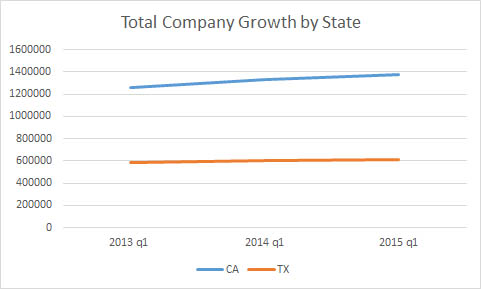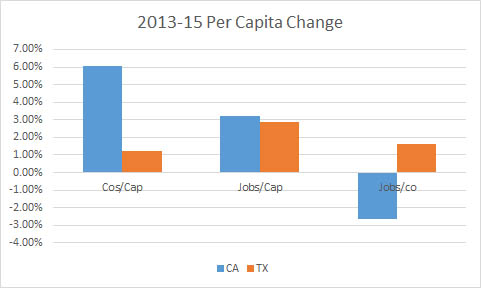I really wasn’t planning to post today, but between an illness forcing me to stay at home, general restlessness, and this cheerleading piece in the DMN that even gets the fancy graphics treatment (the bear is walking off the Cali flag!) about Texas taking jobs and companies from California. The implication being Texas (and its political/economic system) are kicking Cali’s ass (and its political/economic system). Editorializing aside, like Mr. Robot, it scratched that part of my mind. So I decided to do some quick fact checking.
For methodology, I went to US Bureau of Labor Statistics website and found their latest statewide data, which was Q1 2015. I recorded both Cali and Texas data for established businesses, total jobs, and average wages. I then added to the spreadsheet similar data from 2014 Q1 and 2013 Q1. I used these 1) to save time (I’m not going to do every single month of every single year unless someone is paying me, like a commie) and 2) it provides decent apples to apples, especially considering at first glance both were showing steady growth in all months and recent years. Onward and upward.
Since they both were trending upward, I decided to compare their data by growth percentages and per capita, in relation to the population growth of both. So I also added end of year statewide population growth from 2012 (to compare to Q1 2013) and 2014 (for Q1 2015). You can double check my data entry here for 2013, 2014, and 2015.
Here’s how what the data showed.

It seems both states are adding jobs at a similar rate. That certainly doesn’t convey the same message that Texas is taking jobs from California.

While both are adding jobs, change in total businesses tells a bit of a different story. California added 113,854 new businesses at a 9% growth rate whereas Texas added 27,885 businesses at a 4.75% growth rate. One might interpret this as Texas existing businesses are growing whereas California is experiencing more start-ups. It could be argued that this is good either way: strong stable businesses in Texas and combustible cauldron of innovation in California. To each their own. I don’t have the data to go with it, but that dovetails with the perception that young professionals are headed to Cali while families are headed to Texas.

Both are showing average wage growth. Keep in mind, BLS tracks average wage growth which is SIGNIFICANTLY different than median wage growth. I’d have to do more digging to see if median income is rising in both states. As I’ve pointed out on a city level, the delta between average and median income can be used to highlight relative equality or inequality and therefore, opportunity or potentially lackthereof because if Average significantly outpaces Median, that means the wage growth is happening only at the top.
If you recall, Dallas and Houston performed very badly by this metric, where surprisingly San Francisco did well. Who knows, maybe that’s because most SF wage growth is in unreported capital gains/stock options from tech sector? Again, who knows.

Above are the total growth rates for companies, jobs, and jobs per company. As you can see, CA is outpacing Texas in company growth (more startups or relo’s), is also outpacing in job growth (but of course it is a bigger state – wait on that a moment), but is losing in jobs per company. Cali businesses are getting smaller (leaner?), but they’re proliferating.
Is that a good thing? Is it sustainable? Difficult to say. My guess is this is bad short term but good long term. The enhanced competition will drown out the weak, but will forge very strong new companies that could be industry leaders sometime in the future.
On the other hand, I’d guess that big, stable companies in Texas are good for the short-term, but potentially not great for the long-term as big companies and lack of a startup scene might hinder innovation. Big companies aren’t terribly nimble. Just ask the buggy whip industry.

While Texas is a big state, Cali is a bigger state. So I felt compelled to not only normalize for population (per capita), but normalize for population growth since some states are growing faster than others. Some states aren’t growing at all. In this case, both are growing: Texas at 3.5% and Cali at 2.81%.
When we compare per capita growth rates between 2013 and 2015 we start to see a bit more of the story. Texas is doing slightly better in job per capita growth while California is doing better in average wage growth per capita. The big difference again is in the growth of established businesses, which tracks with everything I’ve already written above.
——-
In conclusion, maybe they’re both doing well. And maybe the country is doing pretty well, all things considered (particularly globally). But if California is doing better than Texas despite Texas TAKING ALL THE JERBS, it certainly puts a dent in the narrative that California taxes and whatever other ignorant rhetoric (“THEY’RE LOSERS! ~Trump’d) is hurting its competitiveness. Especially if Texas has to pay for the jobs to locate from Cali. Maybe Texas isn’t competing with California at all and those companies were already looking for ways out. Maybe we’re competing with every other state BUT California? Maybe that’s a more accurate story.



